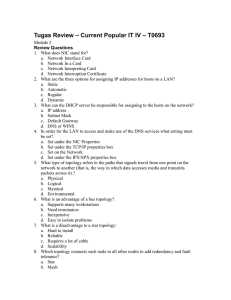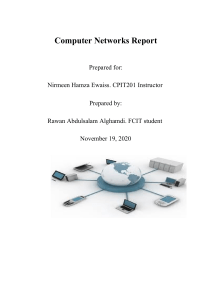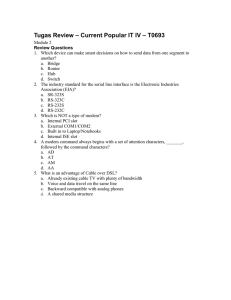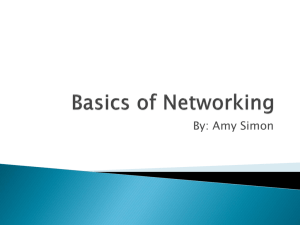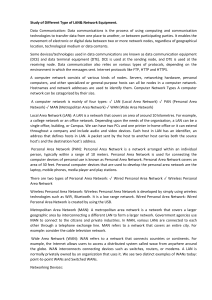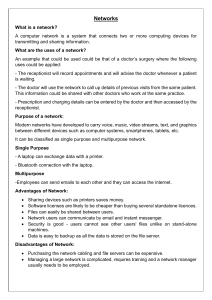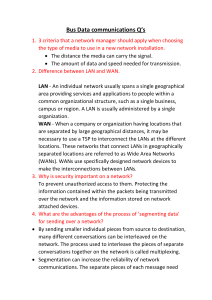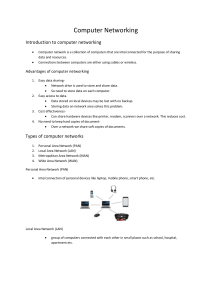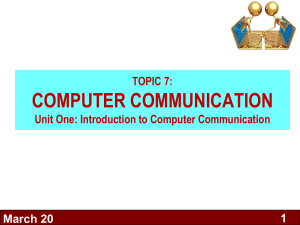Week 3 PPT
advertisement
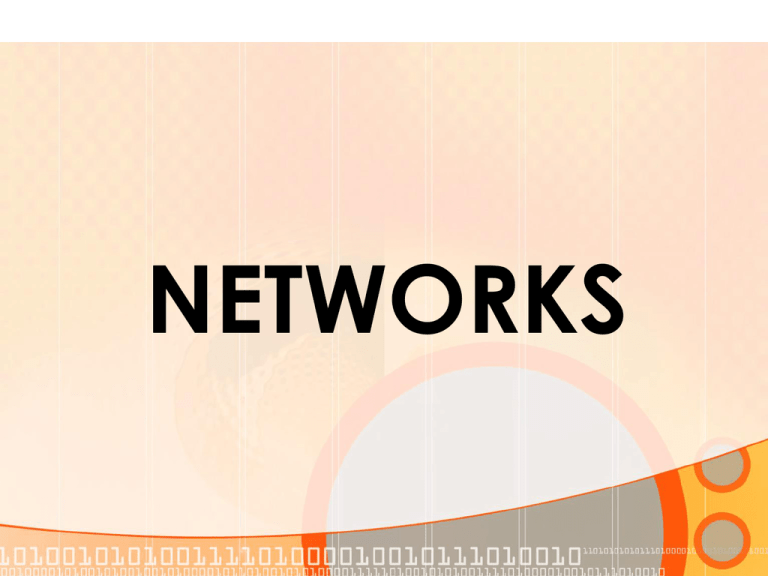
NETWORKS Example • Web Browsing application • Software • Protocols involved • Software • Network Interface Card / Modem • Hardware • Telephone line / Co-axial cable / Air interface • Media Why do you want to have Networks? Uses of Networks • Sharing Resources • 1 printer , many people wanting to print • Access to same data and programs • Servers • Personal Communication • Email • Audio/Video/Data Conferencing Uses of Networks • Access to remote resources • File downloads • Data Backups • Shared storage device • Regular data backup • Greater performance • Distributed computing Types of Computer Networks according to the distance between nodes • LAN: Local Area Network • WAN: Wide Area Network 7 LAN • A network of computers located in the same building or a handful of nearby buildings • Examples: • Computer network at CCIS • Computer network of a University campus 8 WAN • A network in which computers are separated by great distances, typically across cities or even continents • May consist of several interconnected LANs • Example: • The network connecting the ATM of a bank located in various cities • A network connecting the local and overseas offices of a SW house • Internet 9 •INTER NETWORKING •INTERNET •NET Hybrid Networks • Metropolitan Area Networks • Campus Area Networks • Home Area Networks • Personal Area Networks Classification (Geographical Scope) • Wide Area Networks • Metropolitan Area Networks • Campus Area Networks • Local Area Networks • Home Area Networks • Personal Area Networks Software part of a Network • Application • Email • Browsing • Conferencing • Chatting (text/voice) • File Transfer • Audio/Video Streaming Software part of a Network • Protocols • Language that a computer uses to achieve data communication • Set of Rules • Hyper Text Transfer Protocol HARDWARE PART OF A NETWORK Modem • Modem • Modulator/DEModulator • Computer sends data in digital form • Modem provides a hardware interface between computer and telephone lines • Transmission speed upto 56Kbps • V.92 is the current modem standard • Several modem types • Internal • External • Voice • Fax LAN Card • Network Interface Card (NIC) • LAN card • Digital Interface + Protocol • Provides higher data rates Wireless LAN Card • Wireless NIC • Transmission over air is not digital • Provides Interface + Protocol • IEEE 802.11 • Also called Wi-Fi • Institute of Electronic and Electrical Engineers • Several versions • 802.11b connects up to 11Mbps • 802.11g connects up to 56Mbps • 802.11n connects up to 600Mbps • IEEE – Institution of Electrical and Electronics Engineers WLAN Card Now that we have some software and hardware on each computer.. HOW CAN WE CONNECT THESE COMPUTERS? Network Topologies • Topology • Logical layout of wires and equipment • Choice affects • Network performance • Network size • Network collision detection • Several different types Point-to-Point (P2P) Computer A Computer B 23 P2P • Inexpensive • Limited connectivity • Quite often used for connecting two LANs to form a WAN 24 Network Topologies • Bus topology • Also called linear bus • One wire connects all nodes • Terminator ends the wires • Advantages • Easy to setup • Small amount of wire • Disadvantages • Slow • Easy to crash Network Topologies • Star topology • All nodes connect to a single device e.g. hub • Packets sent to hub • Hub sends packet to destination • Advantages • Easy to setup • One cable can not crash network • Disadvantages • One hub crashing downs entire network • Uses lots of cable • Most common topology Network Topologies Network Topology • Ring topology • Nodes connected in a circle • Tokens used to transmit data • Nodes must wait for token to send • Advantages • Time to send data is known • No data collisions • Disadvantages • Slow • Lots of cable Network Topology • Mesh topology • All computers connected together • Internet is a mesh network • Advantage • Data will always be delivered • Disadvantages • Lots of cable • Hard to setup
